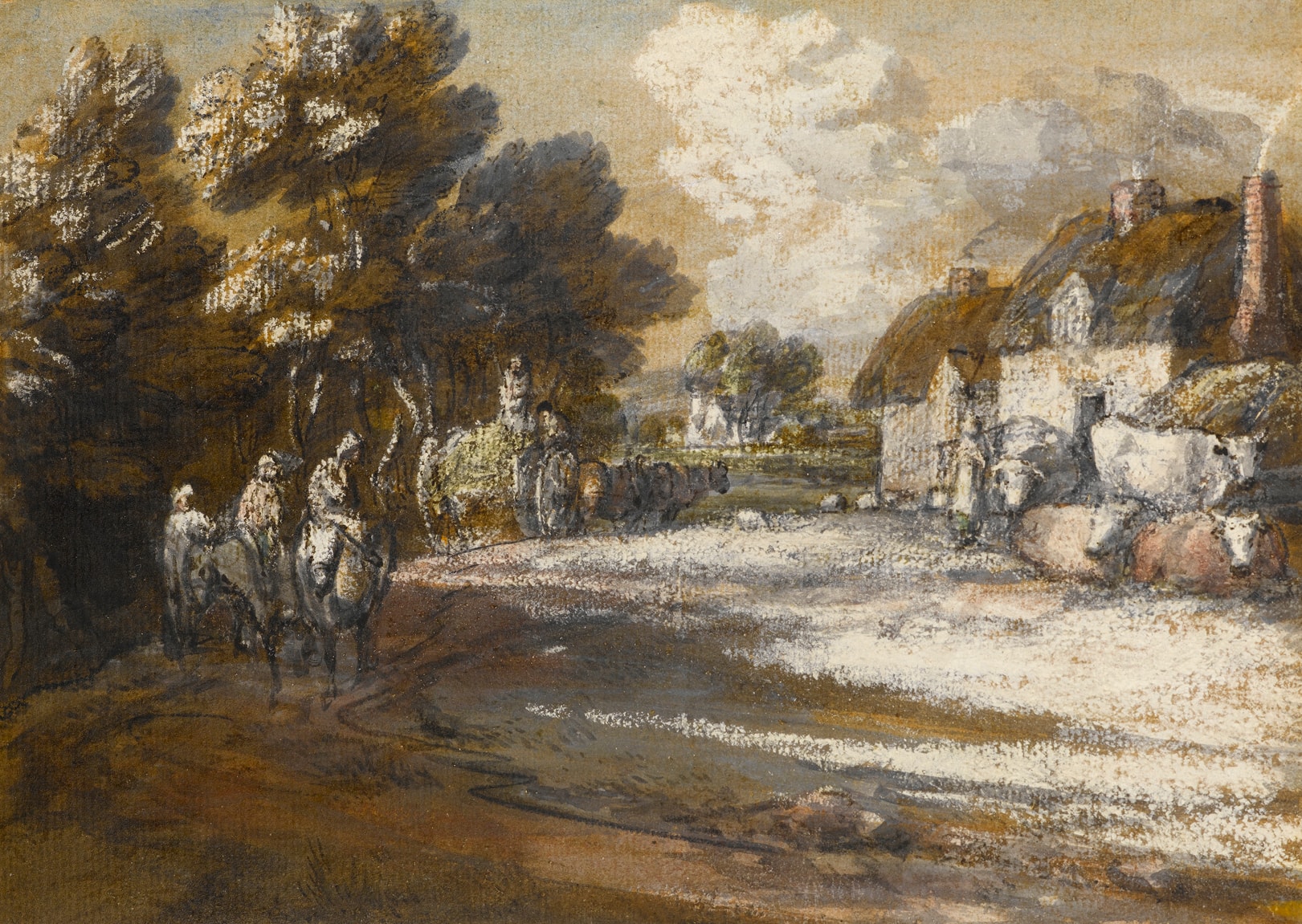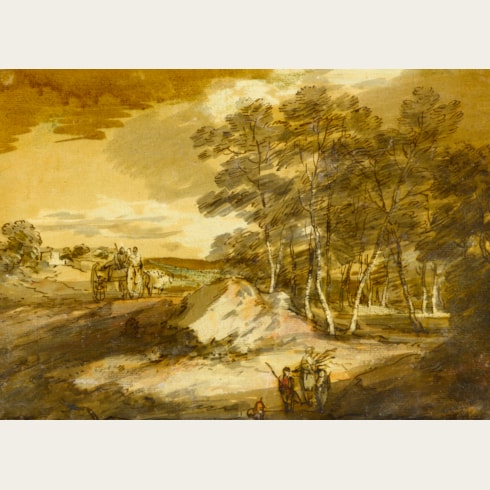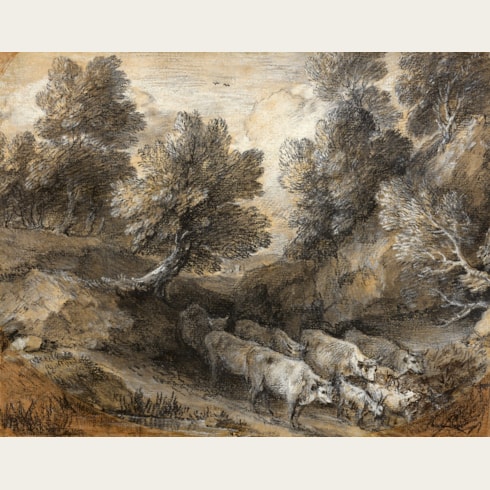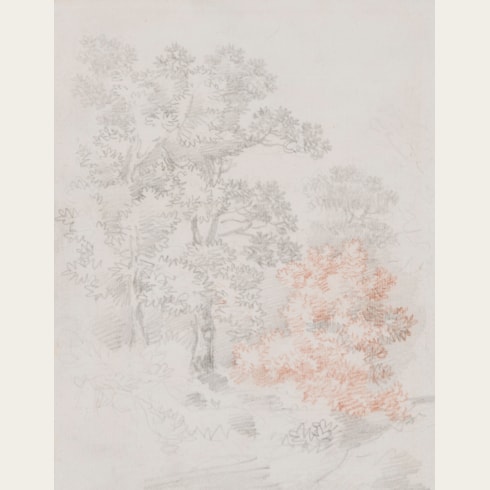Thomas GAINSBOROUGH
(Sudbury 1727 - London 1788)
Travellers Passing Through a Village
Sold
Pencil, black chalk and watercolour, extensively heightened with white, on buff paper.
219 x 308 mm. (8 5/8 x 12 1/8 in.)
219 x 308 mm. (8 5/8 x 12 1/8 in.)
Landscape drawings account for over three-quarters of Thomas Gainsborough’s output as a draughtsman, and include some of his finest works. Indeed, as the scholar John Hayes has aptly noted, ‘Gainsborough was a prolific, indeed compulsive, landscape draughtsman.’ These landscape drawings were done for his own pleasure, in varying degrees of finish, and using a range of different techniques; they are among his most experimental works as a draughtsman. Overburdened with portrait commissions, Gainsborough seems to have turned to the freedom of landscape drawing as a means of relaxation. (As he wrote in a letter to his friend William Jackson, ‘I’m sick of Portraits and wish very much to take my Viol[a] da Gam[ba] and walk off to some sweet Village where I can paint Landskips and enjoy the fag End of Life in quietness & ease.’) The artist’s landscape drawings evince a deeply personal, and often quite poetic, view of nature.
This drawing, of remarkable richness of colour, may be dated to the early 1770’s. At this time Gainsborough was living in Bath, and his landscapes, previously quite rustic in spirit, began to take on a more classical air, with echoes of the paintings of Claude and Rubens that the artist would have seen in private collections in the area. It was also at this time that Gainsborough was experimenting with various combinations of ink, chalk, watercolour and varnish in his landscape drawings. The use of white lead in this drawing to achieve the effect of shafts of bright sunlight would seem to reflect the advice given by Gainsborough to his friend Jackson, in a letter of January 1773, to use for highlights ‘Bristol made white lead which you buy in lumps at any house painters; saw it the size you want for your white chalk; the Bristol is harder and more the temper of chalk that the London’. The dry white lead pigment would then be fixed with skimmed milk.
As the Gainsborough scholar Hugh Belsey has noted of the present sheet, ‘This ambitious drawing uses the complex technique that Gainsborough described in a letter written in 1773 to his friend William Jackson. The extensive use of white lead represents strong sunlight, especially as reflected off the roof of the cottage.’ He further points out that the left half of the present composition is repeated in a watercolour by Gainsborough of a Wooded Landscape with Figures on Horseback Returning from Market, which was given by the artist to John, 2nd Viscount Bateman, in September 17706.
Gainsborough produced a number of other landscape drawings in this elaborate combination of media in the early 1770’s, all of about the same size, and this may be seen as part of his stated desire to imbue his landscape drawings with the depth and intensity of his oil paintings. (Indeed, the only landscape drawings which the artist exhibited in London in his lifetime were ten drawings ‘in imitation of oil paintings’ shown at the Royal Academy in 1772.)
The present sheet may be compared with such stylistically analogous drawings of the late Bath period as a Wooded Landscape with Herdsman, Cow and Church in the Fogg Art Museum in Cambridge, Massachusetts and a Wooded Landscape with Packhorses in the Birmingham Museums and Art Gallery, Birmingham.
This drawing, of remarkable richness of colour, may be dated to the early 1770’s. At this time Gainsborough was living in Bath, and his landscapes, previously quite rustic in spirit, began to take on a more classical air, with echoes of the paintings of Claude and Rubens that the artist would have seen in private collections in the area. It was also at this time that Gainsborough was experimenting with various combinations of ink, chalk, watercolour and varnish in his landscape drawings. The use of white lead in this drawing to achieve the effect of shafts of bright sunlight would seem to reflect the advice given by Gainsborough to his friend Jackson, in a letter of January 1773, to use for highlights ‘Bristol made white lead which you buy in lumps at any house painters; saw it the size you want for your white chalk; the Bristol is harder and more the temper of chalk that the London’. The dry white lead pigment would then be fixed with skimmed milk.
As the Gainsborough scholar Hugh Belsey has noted of the present sheet, ‘This ambitious drawing uses the complex technique that Gainsborough described in a letter written in 1773 to his friend William Jackson. The extensive use of white lead represents strong sunlight, especially as reflected off the roof of the cottage.’ He further points out that the left half of the present composition is repeated in a watercolour by Gainsborough of a Wooded Landscape with Figures on Horseback Returning from Market, which was given by the artist to John, 2nd Viscount Bateman, in September 17706.
Gainsborough produced a number of other landscape drawings in this elaborate combination of media in the early 1770’s, all of about the same size, and this may be seen as part of his stated desire to imbue his landscape drawings with the depth and intensity of his oil paintings. (Indeed, the only landscape drawings which the artist exhibited in London in his lifetime were ten drawings ‘in imitation of oil paintings’ shown at the Royal Academy in 1772.)
The present sheet may be compared with such stylistically analogous drawings of the late Bath period as a Wooded Landscape with Herdsman, Cow and Church in the Fogg Art Museum in Cambridge, Massachusetts and a Wooded Landscape with Packhorses in the Birmingham Museums and Art Gallery, Birmingham.
The musician William Jackson, a close friend of the artist and an early biographer, wrote that ‘If I were to rest his reputation upon one point; it should be on his Drawings...No man ever possessed methods so various in producing effect, and all excellent.’ A prolific draughtsman, Gainsborough apparently never sold any of his drawings, although he is thought to have given away many of them as presents. As Susan Sloman has noted, ‘During his lifetime Gainsborough’s drawings were known to an inner circle of friends, artist and connoisseurs, but not to the wider public.’
Provenance
With Spink, London, in the 1950’s
Capt. Richard Saher de Quincey Quincey, The Vern, Mardon, Herefordshire
Thence by descent to his nephew, until 1998
Anonymous sale, London, Sotheby’s, 9 June 1998, lot 4
Agnew’s, London, in 2002
Private collection, until 2007
W/S Fine Art, London.
Literature
Hugh Belsey, ‘A Second Supplement to John Hayes’s The Drawings of Thomas Gainsborough’, Master Drawings, Winter 2008, p.436, p.494, no.1051, fig.75 (as location unknown).







